Fixing coolant leaks is essential for performance, critical for safety, and necessary for longevity. When you notice a drop in coolant levels or see puddles under your bike, it's not just a minor inconvenience—it's a potential disaster waiting to happen. Neglecting these issues can lead to overheating, engine damage, and costly repairs that could have been easily avoided. So, what should you look for to catch these leaks early, and how can you address them effectively? Understanding the implications of coolant leaks could save you more than just money.
Key Takeaways
- Fixing coolant leaks prevents engine overheating, ensuring reliable bike performance during rides.
- Proper coolant levels help avoid costly engine repairs and extend the lifespan of your bike.
- Regular maintenance and prompt leak repairs enhance fuel efficiency, leading to longer rides.
- Detecting and addressing leaks early can prevent damage to critical components like hoses and radiators.
Importance of Coolant in Bikes
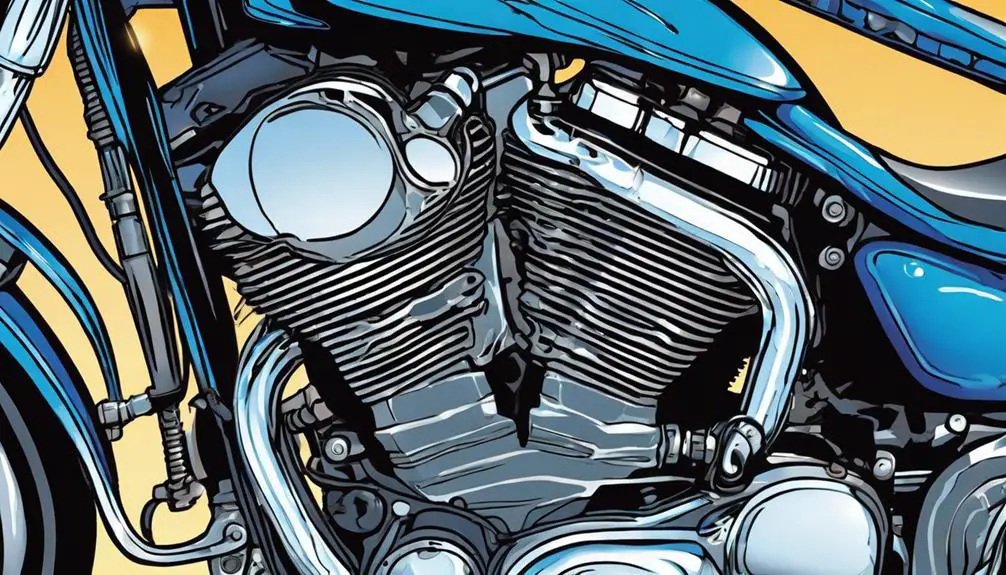
Coolant plays an essential role in keeping your bike's engine at the right temperature, preventing overheating and ensuring ideal performance. When you're out on the open road, you want your machine to run smoothly and efficiently, right? That's where coolant comes in, circulating through the engine to absorb heat and dissipate it effectively.
Without proper coolant levels, your engine can overheat, leading to costly repairs and compromised freedom on your rides. You've got places to go and adventures to chase, and a well-maintained cooling system keeps your bike in top shape. It's about more than just performance; it's about enjoying the ride without worry.
Moreover, maintaining the right coolant levels helps in achieving better fuel efficiency. A cooler engine burns fuel more effectively, which translates to longer journeys without frequent stops for gas. So, ensuring your coolant is up to par isn't just a technical necessity—it's a way to reclaim your time and experiences.
Ultimately, understanding the importance of coolant in your bike empowers you to take control of your ride, ensuring that every journey is as liberating as it should be.
Signs of Coolant Leaks
Recognizing the signs of coolant leaks is essential to maintaining your bike's performance and preventing potential engine damage. One of the most obvious signs is a puddle of fluid beneath your bike when it's parked. This fluid may appear green, orange, or yellow, depending on the type of coolant you use. If you notice a sweet smell, that's another indicator—coolant has a distinct odor.
Another sign to watch for is the overheating temperature gauge. If your bike runs hotter than usual, it could be struggling due to low coolant levels caused by a leak. Pay attention to your bike's performance; if you experience a decrease in power or unusual noises, it might be an underlying issue linked to insufficient coolant.
Also, keep an eye on the coolant reservoir. If you find yourself frequently topping it up, that's a red flag. Finally, check for any visible cracks or damage in hoses and the radiator. These could signal a leak.
Staying vigilant about these signs allows you to address problems early, keeping your bike free and ready for the open road.
Common Causes of Leaks
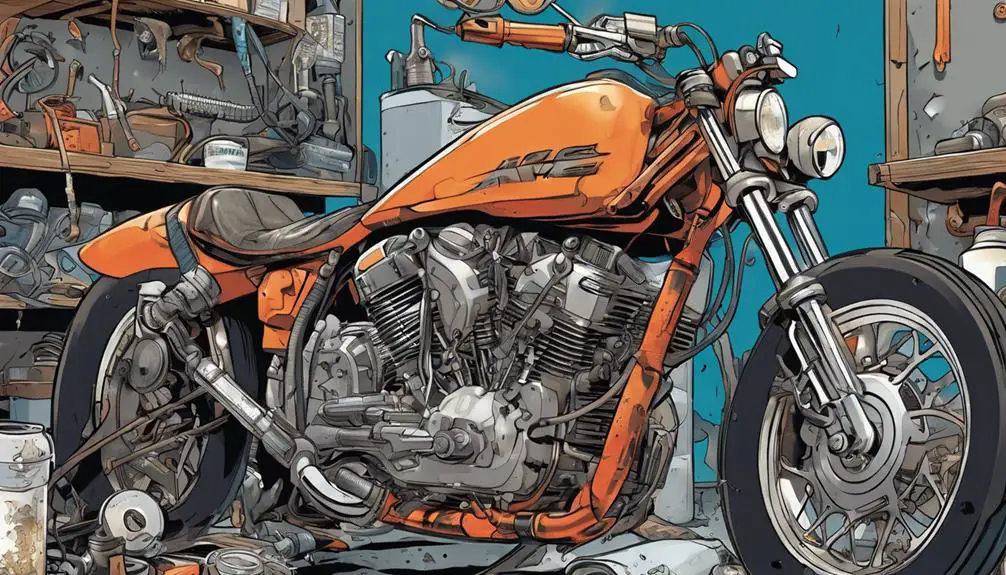
When you're dealing with coolant leaks, it's crucial to identify the common culprits.
Damaged hoses and fittings can create weak points, while corroded radiator components can lead to serious issues.
Understanding these causes will help you tackle the problem effectively.
Damaged Hoses and Fittings
Damaged hoses and fittings often lead to frustrating leaks that can compromise your bike's performance. If you want to experience the freedom of the open road without worrying about coolant issues, it's crucial to keep an eye on these components.
Here are three common causes of damage you should watch for:
- Wear and Tear: Over time, the constant heat and pressure can wear out hoses, making them brittle and prone to cracks.
- Improper Installation: If hoses and fittings aren't installed correctly, they can easily get pinched or strained, leading to leaks.
- Environmental Factors: Exposure to harsh weather conditions, road debris, or chemicals can degrade materials, causing leaks to develop.
Taking proactive steps to inspect and replace damaged hoses and fittings can save you from more significant problems down the line. By maintaining these crucial components, you not only enhance your bike's performance but also embrace the independence that riding brings.
Don't let a small leak hold you back—stay vigilant and enjoy the ride!
Corroded Radiator Components
Corroded radiator components can lead to serious coolant leaks, impacting your bike's efficiency and safety. When you ride, the heat generated can cause metal parts to deteriorate over time, especially in high-moisture environments. If you ignore signs of corrosion, like rust or pitting, you risk not only losing coolant but also overheating your engine.
The most common culprits are radiator caps, fittings, and the radiator itself. A corroded cap can allow coolant to escape, while damaged fittings can cause leaks at connection points. Even small cracks in the radiator can release a torrent of coolant, compromising your ride.
You've got the power to prevent these issues. Regularly inspect your radiator components for signs of corrosion and replace them when necessary. By staying vigilant, you keep your bike running smoothly, enhancing your freedom on the road.
Ignoring corrosion isn't just a mechanical oversight; it's a choice to limit your adventures. So, take charge! Maintain your bike's radiator, and enjoy the liberation that comes with a reliable ride. A well-maintained radiator guarantees that your bike can take you wherever you want to go without the fear of breakdowns.
Inspecting Your Ducati
When inspecting your Ducati, start with a thorough visual check for any signs of coolant leaks.
Don't forget to check your coolant levels regularly to guarantee everything's operating smoothly.
Keeping an eye on these details can help you catch potential issues before they become bigger problems.
Visual Leak Inspection Techniques
To spot coolant leaks on your Ducati, start by inspecting the hoses for any signs of wear or moisture. These components are vital for proper cooling, and any damage can lead to overheating. Don't just glance—get in there and really look.
Here are three key areas to focus on during your inspection:
- Hose Connections: Check the clamps and connections for tightness. Loose connections can lead to leaks, so make sure everything is secure.
- Radiator: Inspect the radiator for any visible cracks or corrosion. A damaged radiator can lead to significant coolant loss, jeopardizing your bike's performance.
- Water Pump: Look at the water pump for any leaks or signs of coolant residue. This part is essential for circulating coolant, and any failure here could spell trouble.
Checking Coolant Levels Regularly
Regularly checking your coolant levels can help prevent overheating and prolong the life of your Ducati, ensuring you catch any issues before they escalate. You don't want to be caught on the road with a bike that's struggling to keep its cool.
Start by locating the coolant reservoir; it's usually a clear tank near the engine. Check the level against the markings on the side—ideally, it should be between the “min” and “max” lines. If it's low, top it off with the recommended coolant type to maintain peak performance. Remember, coolant isn't just a liquid; it's your bike's lifeline, keeping everything running smoothly.
Make this a part of your routine, especially before long rides or after heavy use. You're not just preserving your Ducati; you're embracing the freedom of the open road without the worry of breakdowns.
Also, keep an eye out for any discoloration or debris in the coolant, as these can signal underlying issues. By taking a few moments to check your levels, you empower yourself to ride with confidence and liberation, knowing your Ducati is ready for any adventure.
Tools for Detection
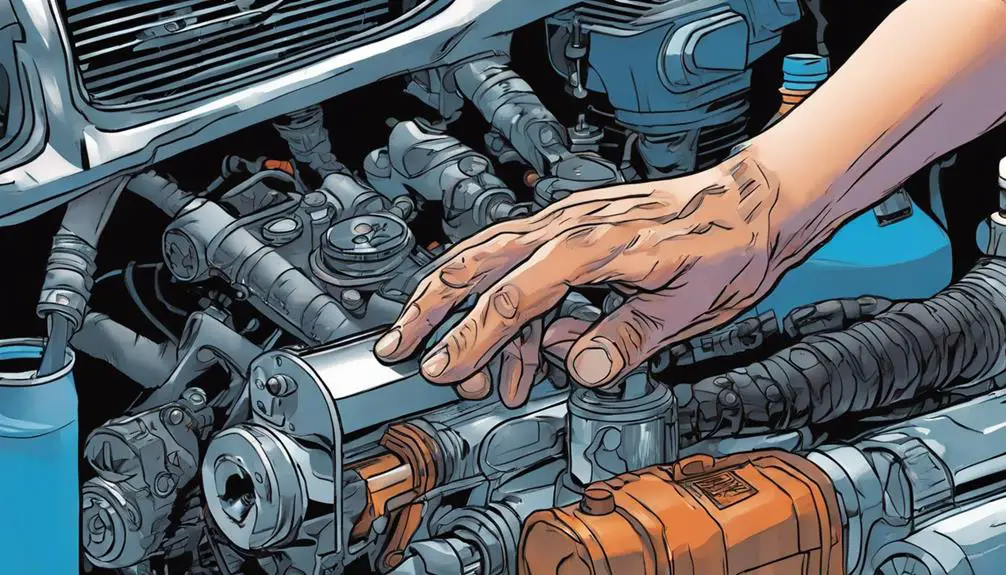
Several effective tools can help you accurately detect coolant leaks in your bike, ensuring you catch issues before they escalate.
Utilizing the right equipment not only empowers you to maintain your ride but also liberates you from the stress of unexpected breakdowns.
Here are three essential tools for detecting coolant leaks:
- UV Leak Detection Kit: This kit includes UV dye and a flashlight. You add the dye to your coolant system, and as it circulates, any leaks will glow under the UV light, making detection simple and precise.
- Pressure Tester: A pressure tester allows you to pressurize your cooling system, simulating normal operating conditions. If there's a leak, you'll notice the pressure drop, pinpointing where the issue lies.
- Coolant System Tester: This handheld device measures the coolant's properties and pressure. By checking for inconsistencies, you can determine if there's a potential leak.
Using these tools, you can take control of your bike's health, ensuring it runs smoothly and efficiently.
Empower yourself with knowledge and the means to maintain your freedom on the road!
Temporary Fixes for Leaks
When you discover a coolant leak, implementing a temporary fix can keep your bike running until you can make a permanent repair. Start by locating the leak. Once you've pinpointed it, clean the area around the leak thoroughly. You want to create a solid bond for your temporary solution.
Next, consider using a sealant specifically designed for coolant leaks. These come in tubes and can be easily applied, forming a barrier that stops the leak.
If you don't have sealant on hand, try using duct tape as a quick fix. Wrap it tightly around the leak, ensuring it covers the area completely. While this isn't a long-lasting solution, it can help you get back on the road for a short time.
Another option is to use a radiator stop leak product, which you can pour directly into the system. This can help seal minor leaks effectively.
Permanent Repair Solutions
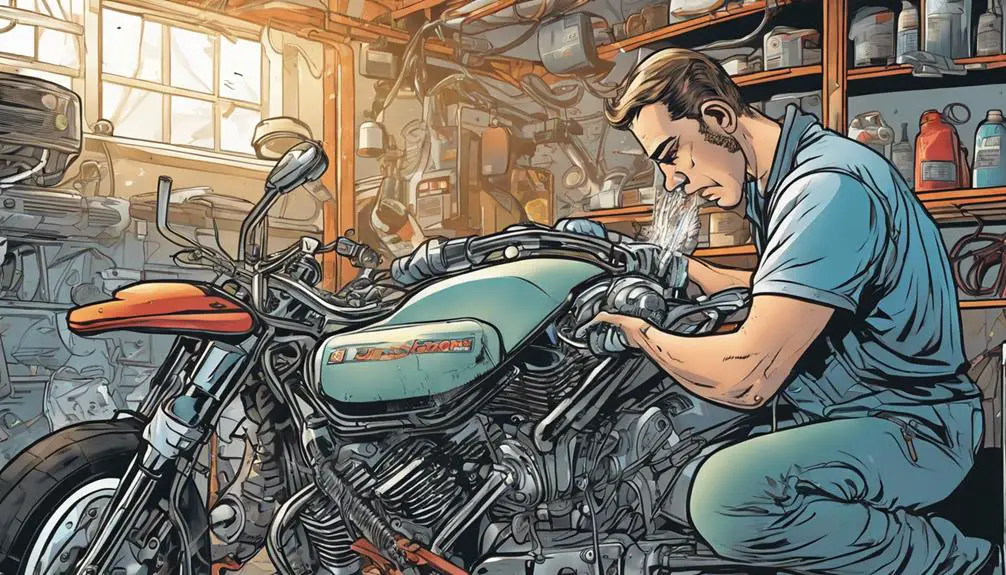
To guarantee your bike runs smoothly and reliably, addressing coolant leaks with a permanent repair is essential. Temporary fixes might keep you going for a while, but they won't set you free from the potential risks and headaches of recurring issues. Opting for a lasting solution allows you to ride with confidence and enjoy the open road without worry.
Here are three permanent repair solutions you can consider:
- Welding: If your bike has a metal coolant leak, welding is a robust way to seal it. A skilled welder can fuse the metal together, creating a strong bond that withstands pressure and heat.
- Epoxy Sealants: For smaller leaks, high-temperature epoxy sealants can provide a solid, lasting fix. These compounds bond well with metal and plastic, offering a reliable barrier against coolant loss.
- Replacement Parts: Sometimes, the best way to permanently fix a leak is to replace the damaged component. Whether it's a hose, radiator, or gasket, new parts guarantee your system operates effectively.
Choosing one of these solutions means you're ready to embrace the freedom of the road, unencumbered by leaks.
Preventative Maintenance Tips
Regularly checking your bike's coolant system can help you catch potential leaks before they become major issues. Make it a habit to inspect the coolant reservoir for any signs of discoloration or sediment. You want clean, clear coolant flowing through your system, ensuring maximum performance and longevity.
Next, examine hoses and connections for cracks or wear. Even small imperfections can lead to leaks, so replace any damaged parts immediately. Don't forget to tighten hose clamps to prevent coolant from seeping out under pressure.
While you're at it, consider flushing the coolant system periodically. This will keep your bike running smoothly and help eliminate any buildup that could cause blockages. A clean system means efficient cooling, and who doesn't want to ride their bike without overheating concerns?
Lastly, keep an eye on your bike's temperature gauge during rides. If it's running hotter than usual, it might be time for a closer inspection. By staying proactive about coolant maintenance, you're not just fixing problems; you're liberating your ride from the stress of potential breakdowns. Embrace these tips, and you'll enjoy countless miles of freedom on your bike!
When to Seek Professional Help
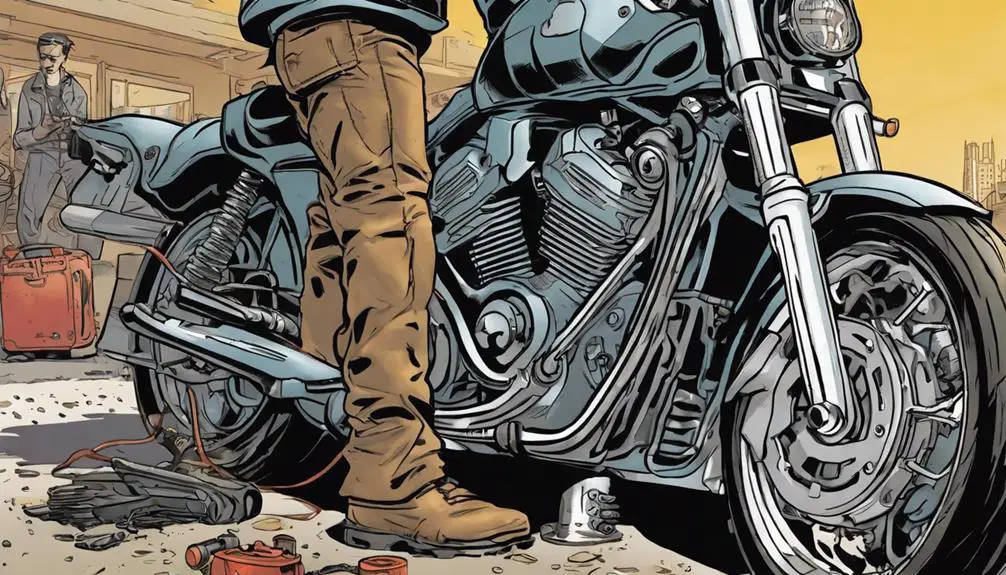
Knowing the signs that indicate you should seek professional help can save you time and money in addressing coolant leaks effectively. Ignoring these signs may lead to bigger issues down the road, jeopardizing your ride and freedom.
Here are three key indicators that it's time to call in the experts:
- Persistent Coolant Puddles: If you notice coolant pooling under your bike regularly, it's a clear sign of a leak that requires immediate attention. Don't let small puddles become a big problem.
- Overheating Engine: If your bike's temperature gauge is climbing higher than normal, you might be facing a coolant leak. An overheating engine can lead to severe damage, so don't wait to get it checked out.
- Unusual Noises: Strange sounds from your engine, like hissing or gurgling, may indicate coolant issues. Trust your instincts—if something feels off, it probably is.
Frequently Asked Questions
How Often Should I Check My Bike's Coolant Levels?
You should check your bike's coolant levels regularly, ideally every couple of weeks, especially before long rides.
If you notice any changes in temperature or performance, do a quick inspection.
Keeping an eye on these levels not only helps maintain your bike's efficiency but also empowers you to take control of your ride.
Regular checks can prevent larger issues down the road, giving you the freedom to enjoy the journey without worry.
Can I Use Water Instead of Coolant in My Bike?
You might think using water instead of coolant is a quick fix, but it's not the best choice.
Water lacks the necessary properties to prevent corrosion and can boil away too quickly. It might cool your bike temporarily, but it won't protect it long-term.
Stick with a proper coolant that's designed for your bike's system. This way, you'll guarantee peak performance and longevity, keeping your ride free from potential damage.
What Are the Risks of Ignoring a Coolant Leak?
Ignoring a coolant leak can lead to serious risks for your bike. You might experience overheating, which can damage the engine and other critical components.
If you're not careful, you'll face costly repairs and reduced performance. Plus, a leak can cause environmental harm, as coolant can be toxic.
Staying alert to these issues means you can maintain your bike's health and enjoy a smoother ride without unnecessary worry.
Don't let a small problem become a big headache!
Are There Coolant Leak Detection Products Available?
Yes, there are several coolant leak detection products available that can help you identify leaks in your bike's cooling system.
You can find UV dye kits, electronic leak detectors, and pressure testers designed specifically for this purpose.
These tools not only simplify the detection process but also enable you to maintain your bike effectively.
How Can Weather Affect My Bike's Coolant System?
Weather's like a fickle friend, always changing and affecting your bike's coolant system.
Extreme temperatures can cause coolant to thicken or thin, leading to inefficient circulation.
Rain and humidity can introduce moisture, potentially leading to rust or corrosion.
You've got to stay vigilant during seasonal shifts to guarantee your coolant's performing at its best.
Keep an eye on the forecast, and your bike's cooling system will thank you for it!
Conclusion
In the grand tapestry of bike maintenance, addressing coolant leaks isn't just a task; it's a commitment to your ride's longevity and performance.
By staying vigilant and proactive, you're not merely avoiding mishaps; you're ensuring a smoother journey ahead.
Embracing regular inspections and timely repairs transforms your biking experience into one of confidence and joy.
So, keep your engine cool and your spirits high—after all, a well-cared-for bike is a true companion on the open road.